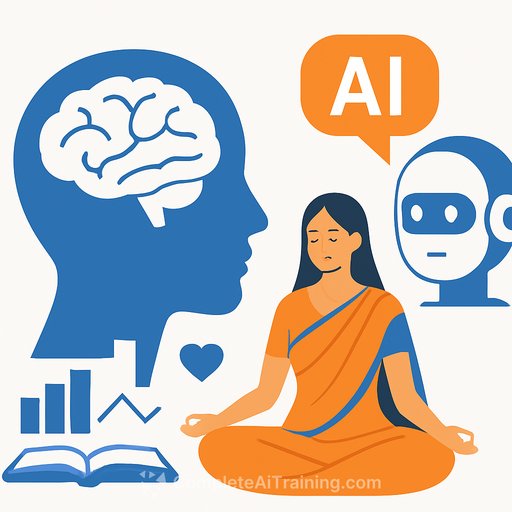AI in Mental Health: What Educators Need to Build Next
One in eight people worldwide lives with a mental health condition. Yet many delay care due to stigma or the hope that things will "get better with time." The WHO reports psychiatric and substance use disorders have risen by 13% in the past decade. The gap in diagnosis, access, and community support is still wide-especially in countries with large populations like India.
Why AI matters right now
Use of AI in mental health has climbed from about 10% of professionals in 2015 to over 60% by 2024. That growth tracks with demand for services and better tools. Deep learning and machine learning now support diagnosis, monitoring, and interventions across dozens of studies. This is a step change in how we can extend support while raising serious ethical questions we must address head-on.
India's reality: scale meets scarcity
India faces a doctor-patient ratio of 1:834 and roughly 0.75 psychiatrists per lakh people. Only 0.06% of the national healthcare budget goes to mental health. In a 2023 study of 787 medical students in North India, 37.2% had considered suicide, 10.9% had intentions, and 3.3% had attempted. The pressure to expand services with smart, ethical technology is clear.
What AI can do today
AI-powered assessments and interviews
Large language models can run structured interviews aligned with DSM-5 criteria and surface patterns in language, facial cues, and behavior that clinicians might miss. Reviews in journals such as Nature Medicine report systems that detect signs of depression or anxiety from language and online activity with high accuracy. Early trials show reductions in anxiety and depression symptoms after AI-supported CBT, and less sadness, anger, and anxiety after virtual reality DBT. These tools don't replace clinicians-they extend reach and add signal.
Risk detection and daily monitoring
NLP models analyze speech or text to flag indicators of depression, anxiety, or suicidal ideation. Vocal biomarkers from everyday conversations can signal risk. Apps can track mood, sleep, and cognitive shifts daily, helping people and providers intervene earlier.
Predictive, more complete diagnostics
By analyzing health records, behavioral data, and (where appropriate) genetics, AI can map risk factors for conditions like schizophrenia before symptoms fully present. Tools often pair with validated measures such as PHQ-8/PHQ-9 and GAD-7 to keep results clinically meaningful. Combining questionnaires with physiological data and observed emotional/cognitive change leads to a more complete picture than interviews alone.
Immediate support and therapy delivery
Chatbots and virtual therapies can deliver CBT skills, mindfulness, and emotional regulation in the moment. They act as psychological first aid while a clinician is looped in, especially useful after hours or in remote regions.
Adoption is uneven-and ethics matter
Despite global momentum, some local surveys (e.g., in Chennai) show low awareness and use of AI among mental health practitioners, often limited to basic chatbots. Concerns about effectiveness and ethics are common-and valid. If you teach, train, or set policy, you're in a position to raise the floor on both competence and safeguards.
Key ethical considerations to build into every course and pilot
- Privacy and confidentiality (data minimization, secure storage, clear retention)
- Informed consent (plain-language disclosures, opt-in, withdrawal options)
- Bias and fairness (representative datasets, subgroup performance checks)
- Transparency and accountability (explainability, audit trails, clear ownership)
- Autonomy and human agency (human-in-the-loop, easy escalation to clinicians)
- Safety (crisis protocols, red teaming, continuous monitoring)
What educators and institutions can do now
You don't need a new department to start. You need a plan, a small stack of tools, and the right guardrails.
Curriculum moves that create real capability
- Make "Data Psychology" core: statistics, measurement, and hands-on work with de-identified health data.
- Clinical Psychology tracks: AI-supported assessment for depression, schizophrenia, OCD; digital PHQ-9/GAD-7; risk triage.
- Counseling tracks: AI-assisted CBT and DBT practice, session summaries, relapse prevention plans.
- Organizational Psychology: AI for training needs analysis, employee well-being screens, engagement insights.
- Forensic Psychology: voice/speech pattern analysis, threat assessment workflows, ethical use boundaries.
- Capstones: build, test, and evaluate a mental health AI workflow with human oversight and a full ethics review.
Starter toolkit for programs
- LLM interview prototypes aligned to DSM-5 with scripted safety checks and escalation paths.
- Speech and text analysis modules for mood and risk signals; dashboards for trend monitoring.
- Digital administration of PHQ-9/GAD-7 with automated scoring and clinician summaries.
- VR-based skills training (mindfulness, distress tolerance) with pre/post measures.
- De-identified sandbox datasets for practice in bias testing, drift detection, and error analysis.
Operational guardrails (bake these in from day one)
- Consent first: plain-language forms; clear limits; no hidden data use.
- Data rules: collect the minimum; encrypt; restrict access; specify retention and deletion.
- Bias checks: evaluate by demographic groups; document gaps; iterate or stop.
- Human oversight: clinicians review risk flags, diagnoses, and care plans before action.
- Safety net: crisis keywords routed to trained staff; 24/7 escalation tree; incident logs.
- Auditability: versioned models, documented prompts, and decision trails for every case.
Addressing the India context
Given clinician shortages and budget limits, AI can extend screening and follow-up without overburdening staff. Start with community-based screening and digital triage to prioritize urgent cases. Train non-specialist staff to use standardized tools supported by AI, with clear referral pathways to psychiatrists and psychologists.
Where to learn more
If you're building courses or upskilling teams, see curated options by role and skill at Complete AI Training - Courses by Job and the latest additions at Latest AI Courses.
Bottom line
AI can extend mental health care, surface risks earlier, and free clinicians to focus on human connection. Education is the lever: teach the tools, teach the limits, and teach the ethics. Build programs that are practical, safe, and measurable-and you'll create graduates who can close the care gap with care.
Your membership also unlocks:






